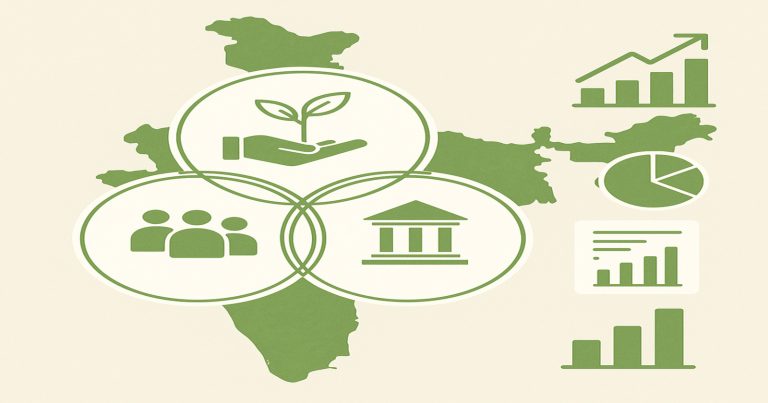Businesses worldwide use an ESG strategy to balance profits with people and the planet. ESG means Environmental, Social, and Governance. An ESG strategy helps companies reduce climate risks, treat people fairly, and follow good governance rules. ESG strategies help build sustainable business models that meet stakeholder and regulatory demands. This guide explains ESG, how to make a strategy, the right metrics, and how to track and report ESG actions.
What is ESG?
Environmental, Social, and Governance (ESG) are three key pillars companies follow to run responsibly. These pillars shape a company’s sustainability strategy and guide actions for future growth. ESG is not only about saving the environment. It is also about being fair to workers, helping society, and using ethical business methods. Companies with a strong ESG framework gain trust, attract investors, and follow new global rules.
Environmental
This pillar covers how a business affects nature. It includes carbon emissions, waste management, water usage, and energy use. A strong net-zero strategy helps reduce environmental damage.
Social
This part looks at how companies treat workers and communities. It includes worker rights, diversity, inclusion, safety, and social impact.
Governance
Governance means how a company runs. A strong ESG governance model promotes fairness, accountability, and transparency. It prevents corruption and builds investor confidence. Every company needs a clear ESG roadmap to connect all three pillars. A good roadmap shows long-term planning, risk control, and growth.
How to Build a Successful ESG Strategy?
A strong ESG strategy is necessary for every successful business. The approach entails a transparent operational game plan in this direction, which provides a set of values linking the company with the needs of the environment, society, and regulators. It acts as a guiding compass in decision-making, risk minimization, and attracting responsible investors concerned with sustainable investing. Strong ESG strategies win companies public trust, creating long-lasting value.
Step 1: Clear Goals for the ESG
Commencing from formulating a clear goal, the ESG target is developed, which must be smart, measurable, and realistic. Each goal would have a relationship to the mission of your company. These would also include climate goals, employee welfare goals, governance-related goals, and goals about the impact on communities. The goals must meet the industry’s specifications and reflect the company’s climate risk management necessities.
Step 2: Develop an ESG Roadmap
An ESG roadmap works like a guide that shows how and when to reach goals. This includes timelines, budgets, roles, and actions. The roadmap must be practical and match the company’s resources. A proper roadmap supports ESG planning and allows companies to track progress.
Step 3: Form ESG Governance Model
Create a structure to manage the ESG journey. Assign ESG leadership or form committees. Add ESG roles to board-level decisions. A good ESG governance model ensures that ESG becomes part of everyday business actions.
Step 4: Focus on ESG Integration
ESG needs to be part of every function. ESG integration means including ESG in finance, HR, procurement, marketing, and operations. This makes the ESG strategy strong and supports company-wide efforts.
Step 5: Communicate with Stakeholders
Stakeholders include investors, customers, regulators, and employees. Share ESG plans and progress with them. Be open and honest. This builds trust and shows real action.
Key Components of an Effective ESG Framework
A strong ESG framework helps build and measure an ESG strategy. It gives structure to ideas and ensures that every part of ESG gets attention. A clear framework helps all departments work together.
- Purpose and Values: Start with the company’s purpose. The ESG actions should match the company’s values. These values become the guide for all ESG efforts.
- Internal Policies and Processes: Write ESG policies and connect them to rules and laws. Add ESG to hiring, procurement, travel, and vendor policies. These rules help staff act responsibly.
- Risk and Impact Assessment: Know your ESG risks. These risks may include pollution, water use, data privacy, or labor practices. Check their impact on business operations. Plan steps to reduce those risks.
- ESG Compliance: Follow global ESG compliance rules like GRI, SASB, and TCFD. Follow local laws for waste, energy, gender equity, and financial reporting.
- Stakeholder Engagement: Talk to people who care about your ESG work. Ask employees, customers, regulators, and community leaders for ideas. Their input helps you build a better strategy.
- Performance Monitoring: Set up ways to track ESG performance indicators. Track targets, measure progress, and find areas for improvement. A solid tracking system ensures better decision-making.
ESG Reporting Standards Every Business Should Know
A good ESG strategy includes proper reporting. ESG reports show how a company is meeting its goals. These reports build transparency and allow others to check ESG performance.
Major ESG Reporting Standards
Companies must choose the proper ESG reporting standards to ensure global recognition. Some popular standards include:
| Standard | Focus |
| GRI – Global Reporting Initiative | Widely used, focuses on all ESG areas |
| SASB – Sustainability Accounting Standards Board | Industry-specific financial impact |
| TCFD – Task Force on Climate-related Financial Disclosures | Climate risks and opportunities |
| CDP – Carbon Disclosure Project | Environmental data and emissions |
| IR – Integrated Reporting Framework | Combines ESG and financial data |
Why ESG Reporting Matters?
Reports help investors make wise choices. They show a company’s commitment to corporate sustainability. Strong ESG reports build investor confidence and help attract green finance and sustainable investing.
Tools for ESG Reporting
Use platforms like Microsoft Sustainability Manager, Workiva, or SAP for easy tracking. These tools link to ESG metrics and show real-time performance.
Top ESG Metrics to Track for Long-Term Sustainability
Tracking the right ESG metrics helps companies grow responsibly. Metrics tell if goals are working. These numbers also help companies compare with others and improve over time.
Environmental Metrics
Track how a company affects nature. Useful metrics include
- Carbon footprint
- Energy use (renewable vs. non-renewable)
- Waste generation
- Water usage
- Emission reduction targets
Social Metrics
Track how the company helps people. Examples include:
- Employee satisfaction rate
- Diversity and inclusion numbers
- Community project outcomes
- Safety incidents
- Training hours per employee
Governance Metrics
Show how the company is run. These include:
- Board diversity
Code of ethics compliance - Number of audits and financial reviews
- Anti-corruption training
- Whistleblower protection
How ESG Metrics Improve Business?
Metrics help fix problems early. They also help in planning better ESG implementation strategies. Tracking helps improve ESG performance indicators and keeps teams focused on results.
Importance of ESG in Modern Business
A strong ESG strategy helps businesses build trust, protect the environment, and create long-term value. It allows companies to meet changing customer expectations, build public trust, and remain legally compliant in an evolving business world.
ESG Builds Competitive Advantage
A company with a good ESG focus gains customer trust, employee loyalty, and investor interest. Most consumers now support brands that follow ethical and sustainable practices. Employees also prefer working for responsible companies that respect diversity, fairness, and safety.
ESG Supports Corporate Sustainability
Businesses today face climate change, social inequalities, and governance risks. An ESG strategy offers a foolproof sustainable business strategy to manage these challenges. It ensures companies make responsible decisions that align with long-term business success and environmental values.
ESG Attracts Sustainable Investing
Investors now look at ESG scores before putting in money. Strong ESG performers attract more sustainable investing and get better access to green finance. Poor ESG performers lose funding and credibility.
ESG Reduces Long-Term Business Risks
Companies face climate disasters, lawsuits, and reputation issues if they ignore ESG. A solid ESG plan lowers ESG risks, protects brand value, and avoids penalties. It builds resilience and future-readiness.
ESG Compliance and Regulatory Landscape
Responsible companies follow clear ESG rules to stay legally compliant and earn trust. These rules come from global ESG frameworks and local laws that guide businesses on reporting and acting on ESG efforts.
Building Internal ESG Governance
Companies build a strong ESG governance model to assign ESG responsibilities to leaders and board members. This model ensures policies are followed and performance is reviewed regularly.
Integrating ESG into Business Functions
Each department plays a part in ESG. Finance tracks green budgets, HR drives diversity, and operations reduce emissions. When all departments align under ESG, ESG integration and overall performance are improved.
ESG and Green Finance Access
Banks and investors now use ESG data to offer or deny funds. Companies with good ESG practices get better interest rates and investor trust. They also access green finance tools and incentives.
Challenges in ESG Strategy Implementation
Many companies want to follow ESG but struggle to implement it. The road from ESG planning to action has several obstacles. Understanding and solving these issues helps companies build stronger ESG outcomes.
Difficulty in Measuring ESG Metrics
Companies often lack tools or systems to track emissions, labor data, or governance audits. This leads to poor ESG metrics and unreliable reports. Digital dashboards and software tools solve this issue.
Lack of Departmental Coordination
Departments often work in silos. Finance may not sync with HR or the supply chain. A strong ESG integration strategy encourages collaboration. It aligns actions across all functions.
High Implementation Costs
Small and mid-sized firms find ESG expensive. They cannot hire full ESG teams or invest in green tech. The solution starts small with priority goals, then expands using a practical ESG roadmap.
Leadership and Staff Awareness Gaps
Many business leaders and staff do not understand ESG. This leads to resistance or half-hearted actions. ESG training programs and leadership engagement are key to overcoming these barriers.
Navigating Complex Compliance
With multiple ESG reporting standards, companies get confused. Different rules apply in other regions. Businesses should focus on one main framework and slowly expand reporting over time.
Relevance to ACCA Syllabus
The ACCA syllabus significantly focuses on corporate governance, risk management, and financial reporting. ESG (Environmental, Social, and Governance) strategy aligns with these themes, especially in Strategic Business Leader (SBL) and Advanced Financial Management (AFM). ACCA expects future accountants to understand how sustainability reporting, ethical business conduct, and stakeholder impact affect financial performance and disclosures.
ESG Strategy ACCA Questions
Q1: What does ESG stand for in the context of strategic reporting?
A) Economics, Sustainability, and Governance
B) Environmental, Social, and Governance
C) Ethical Standards and Guidelines
D) Equity, Stock, and Growth
Ans: B) Environmental, Social, and Governance
Q2: Which global framework supports ESG-related disclosures?
A) COSO Framework
B) IFRS 9
C) GRI Standards
D) Sarbanes-Oxley Act
Ans: C) GRI Standards
Q3: In ESG reporting, which of the following is a governance factor?
A) Waste management practices
B) Board diversity and executive compensation
C) Energy consumption reduction
D) Community involvement programs
Ans: B) Board diversity and executive compensation
Q4: Why is the ESG strategy important in ACCA’s Strategic Business Leader paper?
A) It focuses purely on audit procedures
B) It helps understand the IFRS application only
C) It supports decision-making that considers all stakeholder impacts
D) It limits corporate social responsibility efforts
Ans: C) It supports decision-making that considers all stakeholder impacts
Q5: Which part of ESG addresses labor rights and employee well-being?
A) Environmental
B) Governance
C) Social
D) Strategic
Ans: C) Social
Relevance to US CMA Syllabus
In the US (Certified Management Accountant) CMA syllabus, ESG falls under Part 2: Strategic Financial Management. ESG helps candidates understand non-financial risk factors and how these affect long-term value creation. CMAs must advise management on sustainability goals, cost optimization, and ethical governance, all integral to ESG strategy.
ESG Strategy US CMA Questions
Q1: Which of the following best represents a strategic ESG initiative for a management accountant?
A) Approving tax returns
B) Installing energy-efficient systems to reduce long-term costs
C) Issuing short-term commercial papers
D) Switching from accrual to cash accounting
Ans: B) Installing energy-efficient systems to reduce long-term costs
Q2: ESG-related performance indicators are most likely to appear in which type of reporting?
A) Internal Audit Memo
B) Budget Forecast Reports
C) Integrated Reports
D) Inventory Valuation Sheets
Ans: C) Integrated Reports
Q3: In an ESG strategy, what role does the management accountant play?
A) Setting tax rates
B) Monitoring social impact metrics and advising on financial risks
C) Performing only financial audits
D) Preparing payroll sheets
Ans: B) Monitoring social impact metrics and advising on financial risks
Q4: Why should ESG be integrated into cost control strategies?
A) It reduces the need for financial reporting
B) It eliminates all fixed costs
C) It balances cost efficiency with sustainability goals
D) It boosts short-term profits only
Ans: C) It balances cost efficiency with sustainability goals
Q5: Which social metric could be tracked under an ESG strategy by a CMA?
A) Employee turnover rate
B) Return on assets
C) Depreciation expense
D) Market capitalization
Ans: A) Employee turnover rate
Relevance to US CPA Syllabus
The US CPA exam integrates ESG under Business Environment and Concepts (BEC) and Auditing and Attestation (AUD). CPAs must evaluate ESG disclosures in audit reports and understand how ESG risks affect financial statements. The focus is on transparency, internal control, and governance mechanisms.
ESG Strategy US CPA Questions
Q1: What is the CPA’s role in ESG disclosures?
A) Setting emissions limits
B) Auditing sustainability reports for reliability
C) Approving HR policies
D) Forecasting GDP
Ans: B) Auditing sustainability reports for reliability
Q2: ESG compliance can most directly affect which financial reporting area?
A) Cash Flow from Financing Activities
B) Deferred Tax Asset
C) Asset Impairment and Provisions
D) FIFO vs. LIFO Inventory Method
Ans: C) Asset Impairment and Provisions
Q3: Under ESG governance, which principle must auditors uphold?
A) Confidentiality only
B) Objectivity and professional skepticism
C) Authority over client decisions
D) Cost-benefit rule
Ans: B) Objectivity and professional skepticism
Q4: Which of the following is most likely considered during a CPA’s risk assessment process involving ESG?
A) Exchange rate fluctuations
B) Climate-related financial risks
C) Inventory counting errors
D) Dividend yield changes
Ans: B) Climate-related financial risks
Q5: Why must ESG risks be part of a CPA’s audit strategy?
A) They improve coding standards
B) They show clients how to design IT systems
C) They affect financial reporting and stakeholder trust
D) They help CPAs file tax returns
Ans: C) They affect financial reporting and stakeholder trust
Relevance to CFA Syllabus
The CFA curriculum places ESG within Ethical and Professional Standards, Portfolio Management, and Corporate Issuers. CFA candidates must assess ESG risks and opportunities in investment decisions, portfolio construction, and equity valuation. It’s now a core skill for ethical investing and responsible financial analysis.
ESG Strategy CFA Questions
Q1: What is the primary purpose of including ESG in investment analysis?
A) Maximizing short-term profits
B) Identifying long-term sustainability risks and opportunities
C) Replacing the balance sheet analysis
D) Avoiding regulatory requirements
Ans: B) Identifying long-term sustainability risks and opportunities
Q2: ESG integration in portfolio management focuses on:
A) Just reducing taxes
B) Allocating capital to firms with sustainable practices
C) Limiting the liquidity of assets
D) Increasing leverage ratios
Ans: B) Allocating capital to firms with sustainable practices
Q3: In the CFA ESG framework, what does ESG emphasize?
A) Supply chain logistics
B) Social issues such as labor practices and human rights
C) Shareholder value maximization only
D) Seasonal price movement
Ans: B) Social issues such as labor practices and human rights
Q4: How should ESG be considered during equity valuation?
A) Ignored unless reported in GAAP
B) Treated as a non-financial metric
C) Considered as a key factor impacting risk and cash flows
D) Adjusted only during recession
Ans: C) Considered as a key factor impacting risk and cash flows
Q5: What standard helps analysts evaluate ESG practices across firms?
A) Basel III
B) IFRS 15
C) SASB Standards
D) FIFO Method
Ans: C) SASB Standards


